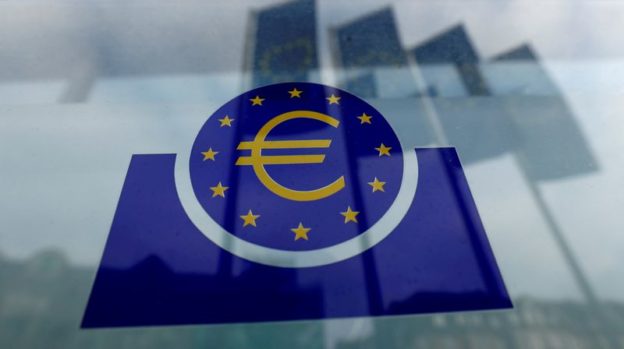Please try another search
Economy10 hours ago (Jul 09, 2021 08:15AM ET)
© Reuters. FILE PHOTO: The European Central Bank (ECB) logo in Frankfurt, Germany, January 23, 2020. REUTERS/Ralph Orlowski
FRANKFURT (Reuters) -European Central Bank policymakers debated a cut in stimulus at their June 10 meeting as the recovery picked up pace but eventually found “broad agreement” to maintain an elevated level of support, the accounts of the meeting showed on Friday.
Facing rising borrowing costs amid a still-fledgling recovery, ECB policymakers concluded that an early retreat from the market could push yields higher and choke off growth as some key sectors were not yet on a solid enough footing, even if growth was now relatively quick.
But that conclusion was only made after conservative policymakers made a push to reduce the pace of bond purchases so ECB policy would stay in sync with improving real economic indicators.
“In view of the better outlook for growth and inflation, and the associated upside risks, it was … also argued that, to provide the same degree of accommodation, asset purchases should be scaled back somewhat,” the ECB said.
Ultimately however, financing conditions were assessed as “too fragile” to allow a meaningful reduction in the pace of purchases without risking a disorderly rise in yields, the ECB added.
“It was stressed that the recovery was at an early stage and lacked robustness, as it depended heavily on policy support,” the ECB said. “A noticeable slowing of the pace of purchases for the next quarter was therefore seen as inappropriate at the current juncture.”
In fact, some policymakers even argued that given a muted inflation outlook over the medium term, even an increase in stimulus could be justified.
Commentary from the June meeting may not provide firm guidance about the bank’s next policy move as a new strategy, unveiled on Thursday, is likely to be the primary guiding force for decisions as early as the ECB’s July 22 meeting.
The new strategy set the bank’s inflation target at 2%, giving up its previous formulation of “below but close to 2%” and signalled that periods of low inflation, as currently experienced, may require more persistent monetary policy action.
While ECB President Christine Lagarde did not fully explain what this would mean in practice, sources close to the discussion said the bank is contemplating a new policy guidance for the July 22 meeting that would signal an even longer period of policy accommodation.
While there was unanimous support for the eventual policy decision in June, several conservative policymakers argued at meeting for somewhat lower bond purchases under the ECB’s 1.85 trillion euro Pandemic Emergency Purchase Programme.
Related Articles
Disclaimer: Fusion Media would like to remind you that the data contained in this website is not necessarily real-time nor accurate. All CFDs (stocks, indexes, futures) and Forex prices are not provided by exchanges but rather by market makers, and so prices may not be accurate and may differ from the actual market price, meaning prices are indicative and not appropriate for trading purposes. Therefore Fusion Media doesn`t bear any responsibility for any trading losses you might incur as a result of using this data.
Fusion Media or anyone involved with Fusion Media will not accept any liability for loss or damage as a result of reliance on the information including data, quotes, charts and buy/sell signals contained within this website. Please be fully informed regarding the risks and costs associated with trading the financial markets, it is one of the riskiest investment forms possible.

Comments are closed